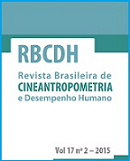Fatores associados à autoavaliação do peso corporal em mulheres praticantes de academia.
DOI:
https://doi.org/10.1590/1980-0037.2015v17n2p175Resumo
Analisar os fatores associados à autoavaliação do peso corporal (AAPC) em mulheres praticantes de exercícios físicos em academias. A coleta de dados foi realizada nas maiores academias da cidade de Presidente Prudente-SP, sendo a amostra constituída por 200 mulheres com idade média de 25,5±9,7 anos. A AAPC foi realizada mediante o preenchimento de questionário com opções de resposta em escala de Likert. As variáveis independentes analisadas foram: acompanhamento com nutricionista, idade cronológica, estado nutricional (avaliado pelo IMC), percepção da qualidade de vida e estado civil. O teste qui-quadrado e a regressão logística binária foram utilizados (p<5%). Encontrou-se elevada proporção de mulheres que autoavaliaram seu peso corporal em outras categorias diferentes da opção normal (59% [IC95%: 52,2–65,8]), sendo que as mulheres com excesso de peso apresentaram uma probabilidade maior dessa ocorrência (3,70 [IC95%: 1,83-7,49]), similarmente àquelas com menor percepção da qualidade de vida (p=0,001). Dentre as partes corporais avaliadas, a insatisfação com a região abdominal foi a única que apresentou associação com a autoavaliação do peso corporal. Existe elevada ocorrência de mulheres que autoavaliaram seu peso corporal em outras categorias diferentes da opção normal, as quais estão associadas às piores percepções de qualidade de vida e excesso de peso. Além disso, a região abdominal parece ser um foco central de preocupação nessas mulheres.
Downloads
Publicado
Edição
Seção
Licença

Direitos Autorais para artigos publicados nesta revista são do autor, com direitos de primeira publicação para a revista. Em virtude da aparecerem nesta revista de acesso público, os artigos são de uso gratuito, com atribuições próprias, em aplicações educacionais e não-comerciais, desde que seja dada a atribuição. Esta obra foi licenciada com uma Licença Creative Commons Atribuição 4.0 Internacional - CC BY


